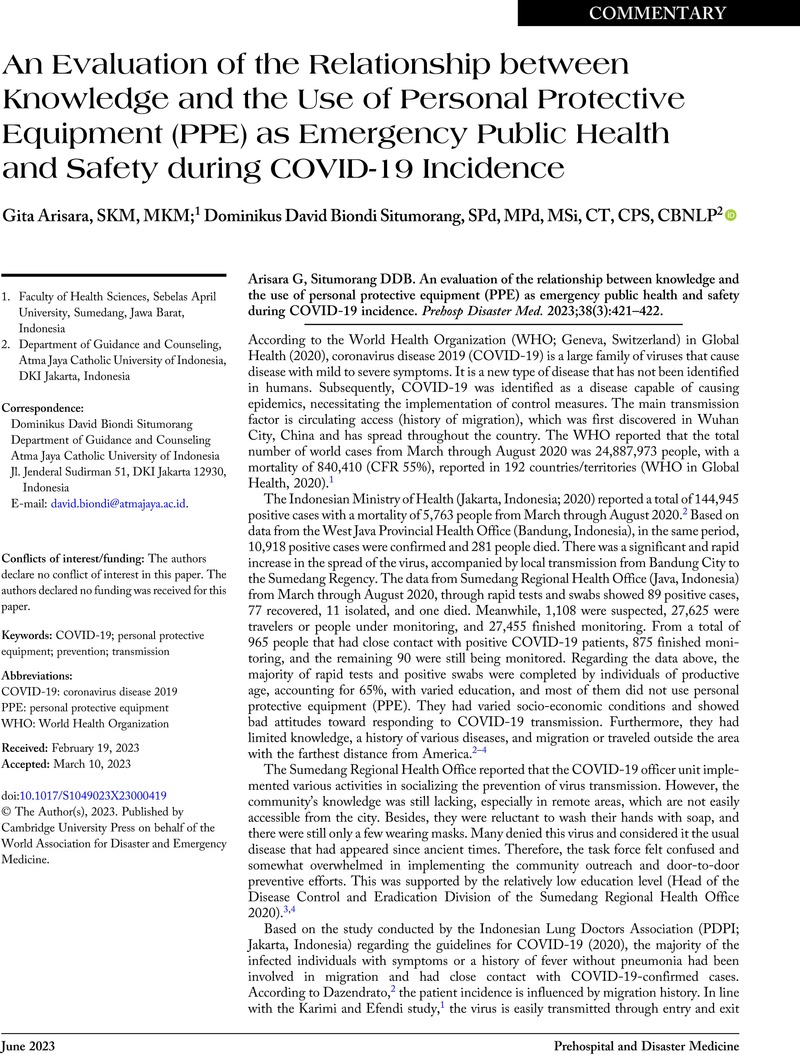No CrossRef data available.
Article contents
An Evaluation of the Relationship between Knowledge and the Use of Personal Protective Equipment (PPE) as Emergency Public Health and Safety during COVID-19 Incidence
Published online by Cambridge University Press: 31 March 2023
Abstract
An abstract is not available for this content so a preview has been provided. Please use the Get access link above for information on how to access this content.

- Type
- Article Commentary
- Information
- Copyright
- © The Author(s), 2023. Published by Cambridge University Press on behalf of the World Association for Disaster and Emergency Medicine
References
Karimi, AF, Efendi, D. [Corona reading: Essays on humans, plague, and the world]. CareMedia Communication. 2022;2(14).Google Scholar
Dazendrato, W. [Movement of prevention rather than cure against the pandemic COVID-19]. J Education and Development. 2021;8(2):242.Google Scholar
Handayani, D, Hadi, DR, Isbaniah, F, Burhan, E, Agustin, H. Coronavirus disease 2019. J Respirol Indonesia. 2022;40(2):119–129.CrossRefGoogle Scholar
Perhimpunan Dokter Paru Indonesia (PDPI). [Diagnosis and Management of Pneumonia COVID-19]. Jakarta, Indonesia: PDPI; 2020.Google Scholar
Kerja, MT. [Regulation of the Minister of Manpower and Transmigration Number]: Per. 08/Men. VII/2010 [About Personal Protective Equipment, Minister of Manpower and Transmigration of the Republic Indonesia, Jakarta]. 2021.Google Scholar
Syakurah, RA, Moudy, J. [Knowledge related to efforts to prevent coronavirus disease (COVID-19) in Indonesia]. HIGEIA (Journal of Public Health Research and Development). 2021;4(3):333–346.Google Scholar
Wati, NMN, Lestari, NKY, Jayanti, DMAD, Sudarma, N. [Optimizing the use of personal protection equipment (PPE) in the community in the context of preventing the transmission of the COVID-19 virus]. Jurnal Empathy Pengabdian Kepada Masyarakat. 2022;1(1):1–8.CrossRefGoogle Scholar
Nasution, DAD, Erlina, E, Muda, I. [The impact of the COVID-19 pandemic on the economy Indonesia]. Jurnal Benefita. 2022;5(2):212–224.CrossRefGoogle Scholar
Ruhyana, NF, Ferdiansyah, H. [Sumedang Regency Government policy strategy for distribution of social assistance during the COVID-19 pandemic]. Jurnal Khazanah Intelektual. 2022;4(2):789–804.CrossRefGoogle Scholar
Wulandari, A, Rahman, F, Pujianti, N, et al. [The relationship between individual characteristics and knowledge of prevention of coronavirus disease 2019 in communities in South Kalimantan]. Jurnal Kesehatan Masyarakat Indonesia. 2020;15(1):42–46.CrossRefGoogle Scholar
Situmorang, DDB. Indonesia is already in a state of ‘Herd Stupidity’: is it a slump? J Public Health (Oxf). 2022;44(4):e637–e639.CrossRefGoogle Scholar
Situmorang, DDB. COVID-19 vaccination: is it mandatory or optional? J Public Health (Ox). 2023;45(1):e138–e139.CrossRefGoogle ScholarPubMed
Situmorang, DDB.
‘Herd stupidity’ as a result of ‘irrational beliefs’: the mental health issues in the COVID-19 outbreak. Asian J Psychiatr. 2021;65:102851.CrossRefGoogle ScholarPubMed



